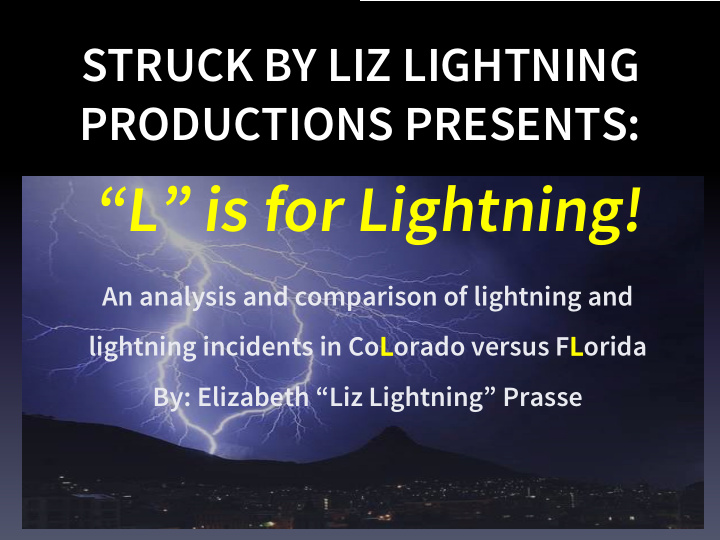



STRUCK BY LIZ LIGHTNING PRODUCTIONS PRESENTS: “L” is for Lightning! An analysis and comparison of lightning and lightning incidents in Co L orado versus F L orida By: Elizabeth “Liz Lightning” Prasse
Why lightning? • Personal survivor of two indirect lightning strikes • Met a fellow lightning strike survivor (direct strike on the toe while working on a turtle farm) • Lightning affects anyone, anywhere
Why Colorado and Florida? • Colorado is my current home • Florida is my future home • Colorado ranks among one of the highest lightning fatalities (3 rd in the U.S. according to The National Weather Service) • Florida = the lightning capital of the U.S. (according to the University of Florida)
Purpose • Analyze the types of lightning incidents in Colorado and Florida from 1995-2016 • Learn why the increase of strikes in both states • Learn why there were more deaths per number of strikes in Colorado than in Florida • Find out does lightning really strike the tallest object?
Methods-Original Research • National Weather Service – Storm Events Database for data on lightning incidents in CO & FL • April 1995 (Optical Transient Detector created) to June 2016 • Vaisala – Lightning detection system timeline • Interviews – Dr. Steve Rutledge-CSU Department of Atmospheric Science – Brody Fuchs -CSU Department of Atmospheric Science – Dr. Tim Canty-University of Maryland Department of Atmospheric and Oceanic Science – Dr. Joseph Champ (thesis committee member)-CSU Department of Journalism and Media Communication, CSU School of Global Environmental Sustainability, U.S. Geological Survey, and USDA Forest Service – Dr. Scott Denning (thesis advisor)-CSU Department of Atmospheric Science
Methods-Secondary Research • National Weather Service (NWS) • National Oceanic and Atmospheric Administration (NOAA) – National Severe Storms Labatory – Colorado Lightning Resource Page
Background-how lightning forms Ice crystals and water droplets in clouds create electrical energy
FL vs. CO lightning • Florida – Warm rain = more liquid precipitation in the clouds – Fewer ice particles = fewer ice particle interactions = fewer lightning strikes • Colorado – Dry air = low relative humidity = condensation reaches the ice particle phase more often – More ice particles = more ice particle interactions = more lightning strikes • Overall, more lightning strikes per thunderstorm in CO than FL
Analyze the types of lightning incidents in Colorado and Florida from 1995-2016
Findings Part 1 • Types of strikes: – Object: • trees • houses/apartment complexes • oil tanks • power lines • transformers • bales of hay • cars • flag poles • sheds • churches • buildings including Hughes Stadium at CSU and the National Weather Service office in Ruskin, Florida
Findings Part 1 Continued – Object-Person: lightning struck a golf club and injured a golfer – Object-Ground-Person: lightning struck a tree that carried the current into the ground and injured nearby pedestrians – Person: hikers, beachgoers, police officers, and farmers – Animal: horses, pigs, buffalo, cattle, dogs, and even a giraffe at Disney’s Animal Kingdom
Findings Part 1 Continued – Ground: occasionally sparked a brush fire, house fire, or structural fire – Ground-Object-Person: lightning struck the ground and went through a metal fence to injury a worker – Ground-Person: lightning struck the ground and injured eight male football players in Colorado Springs
Injuries • tightness or numbness in the chest and other extremities • first, second, and third degree burns • hair standing up on the end • ruptured ear drums • temporary paralysis • unconsciousness • skull fractures • blindness • headaches • trips to the hospital
Learn why the increase of strikes in both states
Findings Part 2 Continued • Better detection systems and equipment like Vaisala • Better observation as we can now see lightning from space – Optical devices in Earth’s orbit • International Space Station • Geostationary satellite • Further research – number of strikes increased due to better equipment? (my current theory) – because thunderstorms are producing more lightning now than before? • Colorado = strikes in 2012 in 2014 • Florida = strikes in 2012 in 2014
Learn why there were more deaths per number of strikes in Colorado than in Florida *Contrast between mountains and plains builds circulation for thunderstorms (ideal weather for lightning)
Learn why there were more deaths per number of strikes in Colorado than in Florida *Contrast between warm ocean and cool land builds circulation for thunderstorms (ideal weather for lightning)
Males vs. Females • 1995-2016 Colorado deaths = males, females • 1995-2016 Florida deaths = males, females – NOT stereotyping – males struck more often because exposed to more lightning than females through: • Recreational activities (fishing, hiking, running) • Work (roof, construction, field)
Findings Part 4 Find out does lightning really strike the tallest object? – Yes! • lightning bolt extends down from the cloud • seeks the closest source of particles of the opposite charge to interact with • strikes a house, building, tree, or whatever the tallest object in the area is
Local Lightning
Conclusion
Sources • "Colorado Lightning Resource Page." Colorado Lightning Resource Page . U.S. Department of Commerce/National Oceanic and Atmospheric Administration/Office of Oceanic and Atmospheric Research, n.d. Web. 31 Aug. 2016. • Canty, Dr. Tim • Champ, Dr. Joseph • Denning, Dr. Scott • Fuchs, Brody • http://www.lightningsafety.noaa.gov/stats/05-14_Flash_Density_State.pdf • http://www.lightningsafety.noaa.gov/stats/97-12Flash_DensitybyState.pdf • "National Weather Service Weather Forecast Office." NWS Melbourne Lightning Information Center . National Weather Service, 31 Aug. 2009. Web. 31 Aug. 2016. • "NOAA National Severe Storms Laboratory." NOAA National Severe Storms Laboratory . U.S. Department of Commerce/National Oceanic and Atmospheric Administration/Office of Oceanic and Atmospheric Research, n.d. Web. 31 Aug. 2016. • "NWS Lightning Safety Home Page." NWS Lightning Safety Home Page . U.S. Department of Commerce/National Oceanic and Atmospheric Administration/Office of Oceanic and Atmospheric Research, n.d. Web. 31 Aug. 2016. • Rutledge, Dr. Steve • "Storm Events Database." National Centers for Environmental Information (NCEI) Formerly Known as National Climatic Data Center (NCDC) . NOAA Chief Information Officer, n.d. Web. 31 Aug. 2016.
Recommend
More recommend